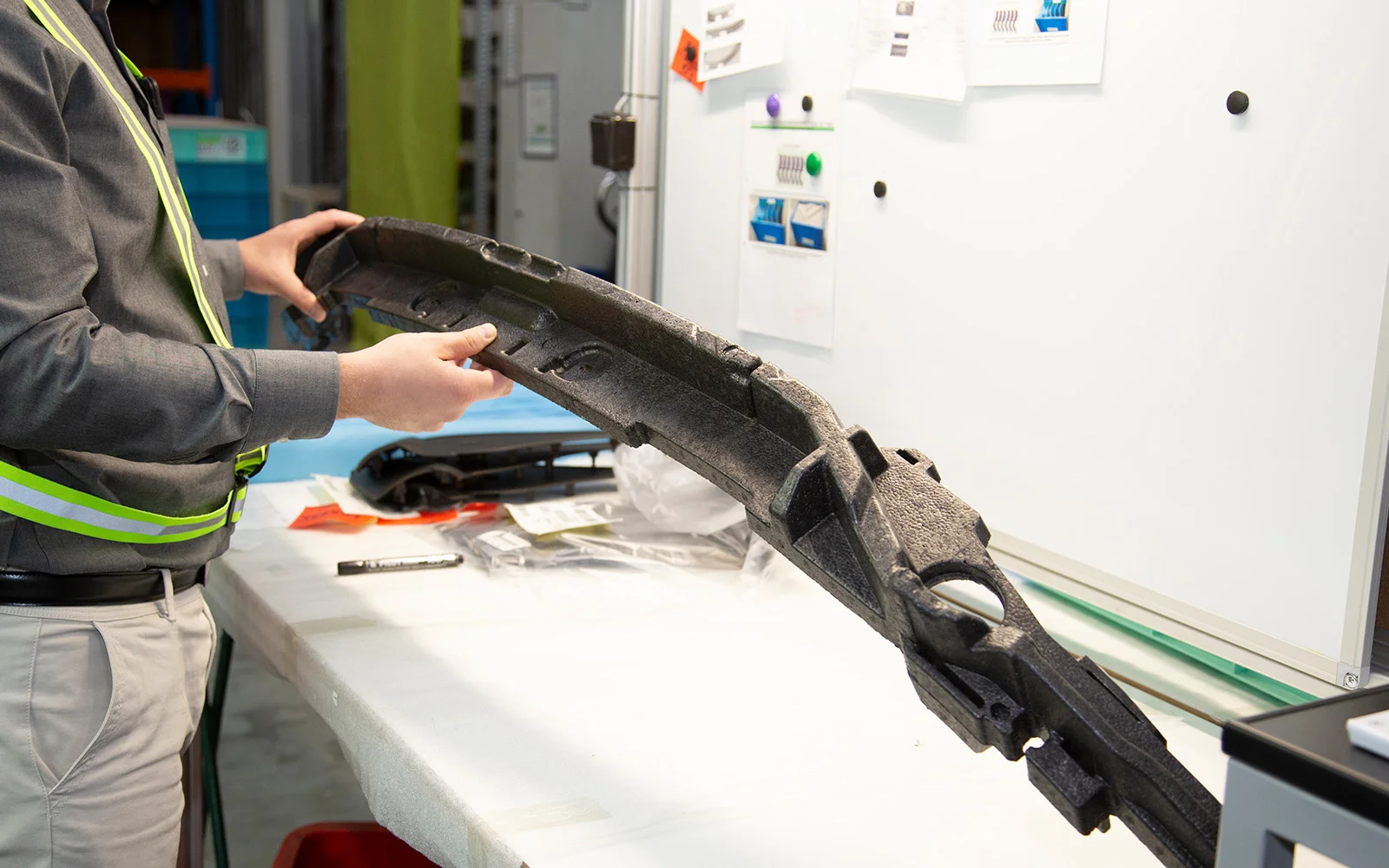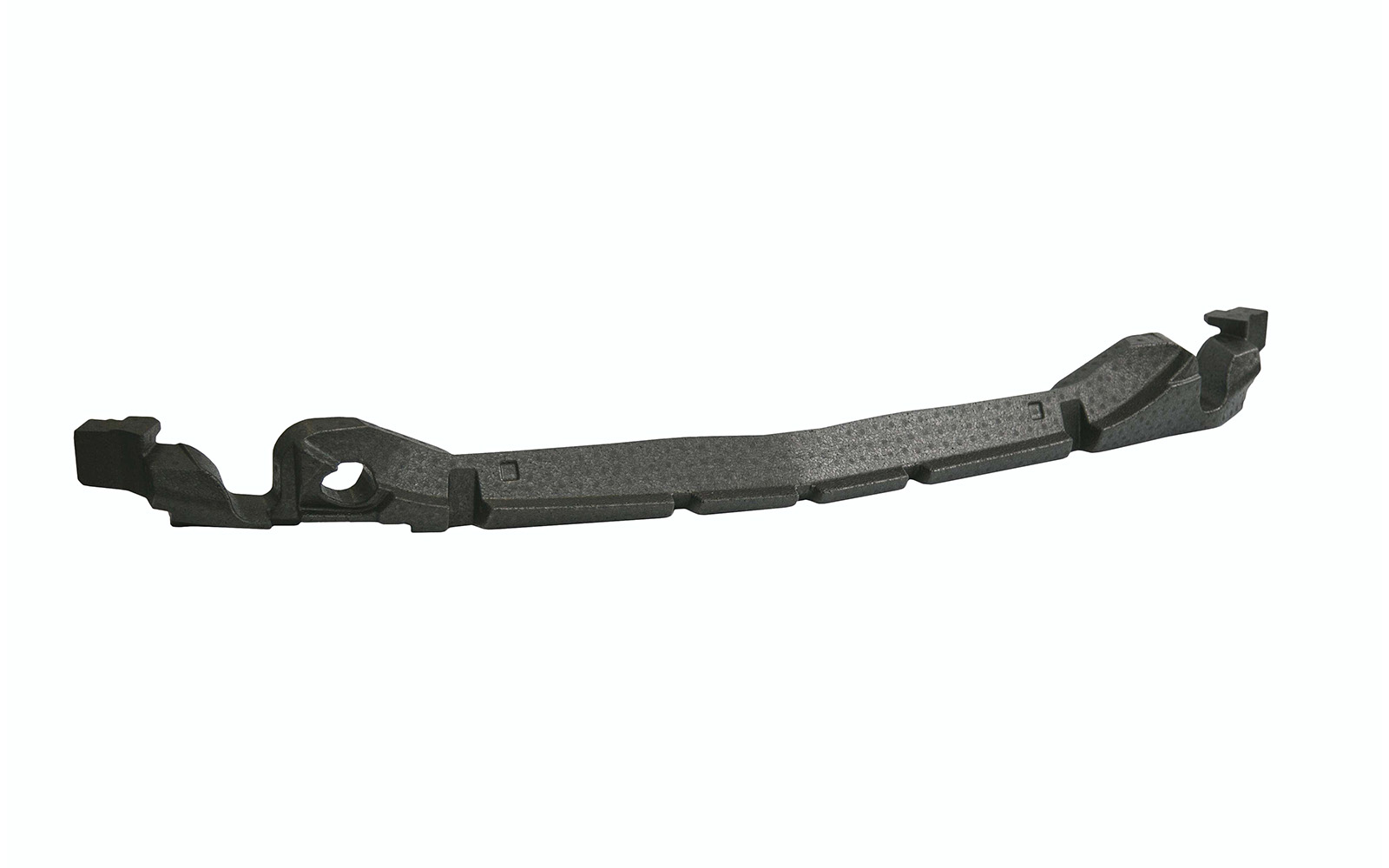The EPP automotive parts moulding technology allows for a simple production of components of different densities. This technology makes it possible to produce parts with varying mechanical strength parameters in one process, depending on the location.
Why does the density of plastic matter?
Density, a measure of the amount of weight per unit volume of a material, is a fundamental physical property that has a direct impact on its other performance characteristics, such as impact strength, stiffness, thermal and electrical insulation and energy absorption capacity, among others. This parameter is usually expressed in units of weight per unit of volume, such as kilogram per cubic metre (kg/m3) or gram per cubic centimetre (g/cm3). In very general terms, the higher the density of the plastic used in automotive construction, the better the protection afforded to users by car parts made of it, e.g. in the event of a collision.

However, a high density is usually associated with greater weight and therefore an increase in the weight of the car and CO2 emissions. This problem is solved by the expanded polypropylene (EPP) pressure-moulding technology, which, on the one hand, gives this material impact strength comparable to traditional hard plastic parts and, on the other hand, helps achieve impressive low weight due to its cellular structure with 95% air content. This contributes to its many other advantages related to thermal and acoustic insulation properties. During the moulding process, the density of EPP can be precisely adjusted depending on the intended use of the component, and it is even possible to obtain parts with varying densities that replace traditional multi-material components.
Density of plastic and mechanical properties
The density of plastic directly affects its mechanical characteristics, i.e. strength, hardness and impact strength (resistance to a certain factor). Depending on the type of forces acting on the component, a distinction is made between tensile, compressive, buckling, shear, bending and torsion strength. As a general rule, higher-density materials tend to have greater resistance to external forces than lower-density ones. Density also influences the hardness of the material. As a rule, the higher the density, the lower the susceptibility to permanent deformation under external forces. This property is critical, especially in structural applications where the material must remain stable and carry all kinds of loads. Parts with different densities have different capacities to absorb impact energy depending on the location. Lower-density materials can be more flexible and absorb impact energy better, which is beneficial when shock absorption is needed. Higher-density materials, on the other hand, can better dissipate energy, which is important in the context of protection against damage. For this reason, for example, harder EPP can be used in the central part of car bumpers, which receive the greatest impact force during an accident, and a lighter material with a lower density can be used on its side parts, which will also have a shock absorption function.
Use of components of different densities

The ability to use materials of different densities gives engineers greater freedom in component design. In this way, more advanced and innovative solutions can be created that perform multiple functions simultaneously and better meet users’ requirements. Components of different densities can be used to optimise crumple zones and other vehicle protection components. For example, bumpers made of higher-density materials can better absorb impact energy, increasing passenger safety. In addition to bumper infill, materials with varying densities can find excellent application in the manufacture of seats, backrests, and headrests. For example, the back and sides of the backrest and the seats can be made from EPP of higher density and impact strength so that it forms a solid “skeleton” that will protect the body in the event of a crash. On the other hand, the central part of the headrest, backrest and seat can be made of a softer material with a lower density to provide comfortable support for the head and spine. Different material densities also allow the chemical properties to be tailored to specific needs. As a general rule, the lower the density of the plastic and the higher the air content, the better the thermal insulation. Therefore, an EPP car battery housing can be composed of an outer layer of material of a higher density and impact strength and an inner layer characterised by a more porous structure for better thermal protection.
Density of plastic – manufacturing process for components of different density
There are many production methods for parts of different density. The most traditional method is to use materials that differ in their impact strength and thermal insulation properties, such as rigid ABS plastic and expanded polystyrene (EPS). However, such a solution is disadvantageous in terms of increased weight and recyclability, and involves a relatively high carbon footprint of production. Some manufacturers use a multilayer moulding technology. It involves the separate moulding of several layers of EPP of different density, which are then mechanically combined into a single component. In the innovative EPP moulding method we use, components with areas of different densities can be manufactured in a single mould and in a single production run. The density of the plastic in the different parts of the component is precisely controlled through a special mould design, which is filled with EPP of different density in isolated zones. In the final moulding stage, zones of different density are combined into a single permanent component. This results in time and cost savings, as well as better recyclability of such single-material EPP car components.
Different density as the key to automotive innovation
The technology for manufacturing EPP components of different density provides entirely new possibilities in the areas of innovation, efficiency and vehicle safety. What is more, it fits perfectly with the trend of manufacturing more efficient and environmentally friendly vehicles and using recycled car parts. Firstly, it contributes to the optimisation of vehicle weight. EPP with increased density and impact and deformation strength can only be used in the areas that receive the greatest impact force, thus increasing safety without adding too much weight to vehicles. The use of lightweight, mono-material components leads to lower fuel consumption and CO2 emissions, which is beneficial both for the environment and from the point of view of vehicle operating costs. Lighter cars need less energy to move, which translates into better fuel efficiency. In summary, a strategy of different density in components is a key element in the efforts to produce more efficient and greener vehicles. It can result in improved performance, safety and environmental performance at a low cost.